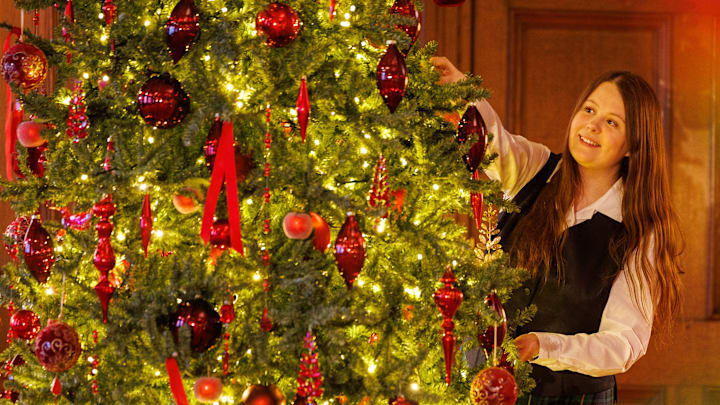The tradition of decorating evergreen trees at Christmastime first emerged in Europe in the Middle Ages. From there, it was taken to America by German immigrants, while across in England, the practice was popularized by the German spouses of King George III and Queen Victoria in the late 1700s and early 1800s.
Ornamented trees have been a popular and widespread Christmas staple ever since.
The History of Decorating Christmas Trees
Precisely what we’ve hung on our Christmas trees to decorate them each year has changed over the centuries, though. The Lutheran Germans who first helped to establish the tradition typically decorated their so-called “paradise tree” (a relic of ancient religious plays and performances) with a mixture of apples, dried fruits, sweet bread, wafers, and other sugary treats, all intended to act as symbols of the biblical Garden of Eden.
The Victorians—inspired by a famous sketch of Queen Victoria’s royal family standing around a tree decorated with toys, candles, and baubles—were quick to see a market in manmade ornaments and shiny trinkets, and produced glass baubles and glittering metal toys that could be suspended from the branches using ribbons. And as manufacturing techniques improved, Christmas turned kitsch in the 20th century, with the first mass-produced strings of electrical lights and reflective plastic tinsel.
Why Popcorn?
But it was way back in 1842 that a German-born teacher named Charles Minnigerode is known to have used garlands of popcorn to decorate a Christmas tree that he put up in Williamsburg, Virginia. Minnigerode certainly wasn’t the first person to use popcorn as a decorative object (the Aztecs had used popped corn kernels on the likes of ceremonial headdresses and even jewelry), yet his Christmas tree is the earliest that we know to have been adorned with garlands of popcorn. But why use popcorn at all?
Well, at least part of the answer to that question involves the date of Minnigerode’s tree. The tradition of decorating Christmas trees would have certainly been fairly well established by that time, but the mass-production and widespread availability of metal ornaments, sparkly toys, and colorful glass baubles was still several decades away.
As a result, people would have had to have taken something of a do-it-yourself approach to either finding or making Christmas decorations for their trees, and so would have relied on items and other materials that they would have found easy to come by at home. So, as well as strings of readily available popcorn, early American trees were often decorated with the likes of cutout paper shapes, seed pods, dried slices of apple, pine cones, and sugarwork—anything and everything that people would have found easy to lay their hands on.
As the country’s staple food in the mid-19th century, moreover, corn would have been not only plentiful and freely available at that time, but relatively inexpensive too, making it all the more attractive as a makeshift Christmas decoration. Yet the use of popped corn was also a neat way of continuing the long-standing tradition of using edible produce as Christmas decorations, too.

In fact, as well as popcorn, American Christmas trees in the 19th century were often festooned with the likes of sugar cookies, raisins, apples, threaded strings of dried cranberries, and marzipan—and even Minnigerode’s tree is known to have also been decorated with nuts as well as garlands of popcorn.
All of this harks back to the ancient Lutheran tradition of the “paradise tree,” with the decorative use of fruits, sweets, and other foodstuffs intended to symbolize the bounty of the Garden of Eden.
So when you’re stringing together garlands of popped corn for the tree this year, you’re not only continuing a long-standing American festive tradition, but an even longer-standing practice whose roots lie in the European Middle Ages.
